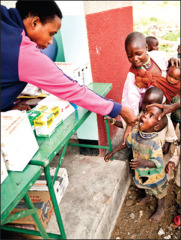Our official English website, www.x-mol.net, welcomes your
feedback! (Note: you will need to create a separate account there.)
Where is the science in humanitarian health?
The Lancet ( IF 98.4 ) Pub Date : 2017-06-08 , DOI: 10.1016/s0140-6736(17)31275-8 Ronald J Waldman , Michael J Toole
 In 1948, in the aftermath of the partition of India and Pakistan, a journal article on the health situation of refugees and internally displaced persons stated that “this report is based entirely on impressions”.1 Another of the earliest articles about a humanitarian emergency, the East Bengal cyclone in 1970, stated that “relief supplies and volunteers poured in, but no one knew the magnitude or geographic distribution of losses and needs.”2 How did these volunteers know what skills were needed? What supplies and commodities to distribute? How did they know where to go or who to help? Impressions, best intentions, and customary practices were the rule at the time, and health interventions were rarely supported by epidemiological or clinical studies that provided evidence of effectiveness.
In 1948, in the aftermath of the partition of India and Pakistan, a journal article on the health situation of refugees and internally displaced persons stated that “this report is based entirely on impressions”.1 Another of the earliest articles about a humanitarian emergency, the East Bengal cyclone in 1970, stated that “relief supplies and volunteers poured in, but no one knew the magnitude or geographic distribution of losses and needs.”2 How did these volunteers know what skills were needed? What supplies and commodities to distribute? How did they know where to go or who to help? Impressions, best intentions, and customary practices were the rule at the time, and health interventions were rarely supported by epidemiological or clinical studies that provided evidence of effectiveness.
中文翻译:

人道主义卫生科学在哪里?
 1948年,在印度和巴基斯坦分割之后,一篇有关难民和国内流离失所者健康状况的期刊文章指出:“本报告完全基于印象”。1关于人道主义紧急情况的另一篇最早文章是1970年的东孟加拉飓风,它说:“救援物资和志愿者涌入,但没人知道损失和需求的严重程度或地理分布。” 2个这些志愿者如何知道需要什么技能?要分配什么供应品和商品?他们怎么知道去哪里或向谁寻求帮助?印象,最好的意图和习惯做法是当时的规则,健康干预很少受到流行病学或临床研究的支持,而流行病学或临床研究提供了有效的证据。
更新日期:2017-11-17
1948年,在印度和巴基斯坦分割之后,一篇有关难民和国内流离失所者健康状况的期刊文章指出:“本报告完全基于印象”。1关于人道主义紧急情况的另一篇最早文章是1970年的东孟加拉飓风,它说:“救援物资和志愿者涌入,但没人知道损失和需求的严重程度或地理分布。” 2个这些志愿者如何知道需要什么技能?要分配什么供应品和商品?他们怎么知道去哪里或向谁寻求帮助?印象,最好的意图和习惯做法是当时的规则,健康干预很少受到流行病学或临床研究的支持,而流行病学或临床研究提供了有效的证据。
更新日期:2017-11-17
The Lancet ( IF 98.4 ) Pub Date : 2017-06-08 , DOI: 10.1016/s0140-6736(17)31275-8 Ronald J Waldman , Michael J Toole

|
 In 1948, in the aftermath of the partition of India and Pakistan, a journal article on the health situation of refugees and internally displaced persons stated that “this report is based entirely on impressions”.1 Another of the earliest articles about a humanitarian emergency, the East Bengal cyclone in 1970, stated that “relief supplies and volunteers poured in, but no one knew the magnitude or geographic distribution of losses and needs.”2 How did these volunteers know what skills were needed? What supplies and commodities to distribute? How did they know where to go or who to help? Impressions, best intentions, and customary practices were the rule at the time, and health interventions were rarely supported by epidemiological or clinical studies that provided evidence of effectiveness.
In 1948, in the aftermath of the partition of India and Pakistan, a journal article on the health situation of refugees and internally displaced persons stated that “this report is based entirely on impressions”.1 Another of the earliest articles about a humanitarian emergency, the East Bengal cyclone in 1970, stated that “relief supplies and volunteers poured in, but no one knew the magnitude or geographic distribution of losses and needs.”2 How did these volunteers know what skills were needed? What supplies and commodities to distribute? How did they know where to go or who to help? Impressions, best intentions, and customary practices were the rule at the time, and health interventions were rarely supported by epidemiological or clinical studies that provided evidence of effectiveness.
中文翻译:

人道主义卫生科学在哪里?
 1948年,在印度和巴基斯坦分割之后,一篇有关难民和国内流离失所者健康状况的期刊文章指出:“本报告完全基于印象”。1关于人道主义紧急情况的另一篇最早文章是1970年的东孟加拉飓风,它说:“救援物资和志愿者涌入,但没人知道损失和需求的严重程度或地理分布。” 2个这些志愿者如何知道需要什么技能?要分配什么供应品和商品?他们怎么知道去哪里或向谁寻求帮助?印象,最好的意图和习惯做法是当时的规则,健康干预很少受到流行病学或临床研究的支持,而流行病学或临床研究提供了有效的证据。
1948年,在印度和巴基斯坦分割之后,一篇有关难民和国内流离失所者健康状况的期刊文章指出:“本报告完全基于印象”。1关于人道主义紧急情况的另一篇最早文章是1970年的东孟加拉飓风,它说:“救援物资和志愿者涌入,但没人知道损失和需求的严重程度或地理分布。” 2个这些志愿者如何知道需要什么技能?要分配什么供应品和商品?他们怎么知道去哪里或向谁寻求帮助?印象,最好的意图和习惯做法是当时的规则,健康干预很少受到流行病学或临床研究的支持,而流行病学或临床研究提供了有效的证据。











































 京公网安备 11010802027423号
京公网安备 11010802027423号